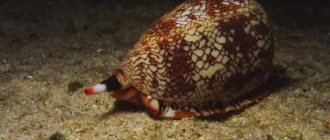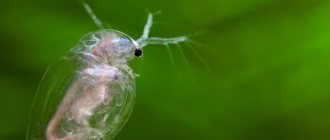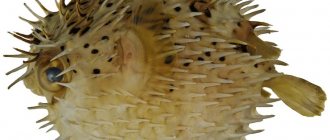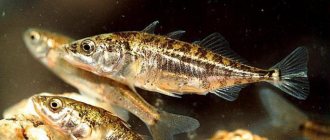- Wild animals
- >>
- Other animals
The sea star (Asteroidea) is one of the largest, most diverse and specific groups. There are about 1,600 species distributed throughout the world's oceans. All species are grouped into seven orders: Brisingida, Forcipulatida, Notomyotida, Paxillosida, Spinulosida, Valvatida and Velatida. Like other echinoderms, starfish are important members of many benthic marine communities. They can be voracious predators, having a significant impact on community structure. Most species are generalist predators.
The structure of starfish
The stars are the closest relatives of the darters and somewhat more distantly related to sea urchins and sea cucumbers. In total, about 1,700 species of these echinoderms have been studied. They all have bright colors and common features in their body structure.
External features of starfish
Starfish, photos of which are presented later in the article, belong to the echinoderm class of invertebrates. They are named so because of their appearance, which resembles a 5-rayed star, although varieties with 3, 6 or more rays are known. One of the subspecies has as many as 30 ray processes.
The body of representatives of echinoderms consists of a central circle and processes extending from it - rays, which make the body of starfish radially symmetrical. The length of the “arms” relative to the body varies. The rays of some are long and thin, others are triangular, wide at the base. There is a species whose tentacles are so small that they hardly stand out against the background of the body.
The color scheme of these marine inhabitants is also very diverse, as is the texture of the skin. The body of a starfish can be smooth or spiny to the touch, rough or pleasantly velvety. The rainbow of colors includes almost all shades of the colors of the rainbow, some are completely black.
Internal skeleton and muscles
The simplest at first glance, starfish have complex internal systems with their own characteristics:
- The internal skeleton of invertebrates does not have individual bones, only many calcareous plates that are woven into an openwork system.
- The spikes of some stars are nothing more than skeletal elements that have come out through the erased skin.
- The muscular system that connects the skeletal plates is poorly developed and after death the star simply falls apart.
- The digestive system is well developed and is located in the central part of the body. The stomach consists of two sections. The opening that serves as the mouth is located on the lower abdominal cavity. Not all species have an anus; most stars expel waste products through the mouth.
- The main system, which is characteristic only of echinoderms, is ambulacral. This water-vascular structure consists of many channels filled with fluid. The movement of the star's rays occurs in the process of pumping liquid by this organ from one part to another. It is this system that is designed for breathing, movement, excretion and touch. The channels of the natural mechanism penetrate the entire body of the sea star and end at the ends of the rays with ambulactic legs with suction cups at the ends.
Sense organs of starfish
The starfish does not have a brain; it is replaced by a nerve ring in the center, which contains nerve bundles and several interconnected brain cells.
However, many sense organs are very developed:
| Sense systems | Degree of development | Functionality |
| Vision | Weak | Primitive eyes, which can only distinguish between light and dark, are located at the ends of the rays. The stars do not see individual objects. |
| Smell | It varies in different species: from very strong to complete absence. | Some types of stars are able to smell food at a great distance, others cannot smell it nearby, but all are very sensitive to chemicals and die when heavily polluted. |
| Touch | Very much | It is with the help of this sense that stars make their way, identify enemies and food. With the help of special processes, they constantly cleanse themselves of sand and parasites. |
| Other feelings | Weak | Lungs and gills are missing. Breathing is carried out through skin processes on the upper part of the body. Therefore, the presence of oxygen is very important for stars. |
Cunning hunters
Many people are interested in how starfish eat. A brief description of the structure of their digestive system can be found below. These amazing beauties create the impression of complete security. In fact, they are sea predators, voracious and insatiable. Their only drawback is their slowness. Therefore, they prefer a stationary delicacy - mollusk shells. The starfish eats scallops with pleasure, and is not averse to eating sea urchins, sea cucumbers, and even fish that carelessly swim too close. The fact is that the starfish has practically two stomachs, one of which can turn outward. An unwary prey, captured by the pedicellariae, is transferred to the mouth opening in the center of the rays, then the stomach is thrown over it like a net. After this, the hunter can release the prey and slowly digest it. For some time, the fish even drags its executioner along with it, but the victim can no longer escape. Everything that a starfish eats is easily digested in its stomach.
She acts somewhat differently with shells: she slowly approaches the dish she likes, entwines the shell with her rays, places her mouth opening opposite the slit of the shell and begins to move the shells apart.
As soon as even a small gap appears, the external stomach is immediately pushed into it. Now the sea gourmet calmly digests the owner of the shell, turning the mollusk into a jelly-like substance. This fate awaits any eaten victim, no matter whether the starfish feeds on a scallop or a small fish.
Types of starfish
Starfish are distinguished by a wide variety of species, which are systematized according to common characteristics. The photos of these underwater beauties are so different from each other that it’s hard to believe that they were taken from animals of the same genus. The classification of this class consists of 300 genera, 30 families and 9 orders.
The most common among them:
- Brisingids are graceful stars that live at a depth of 7-8 km. They are distinguished by long and flexible rays with a small body, which reach up to 45 cm, of which there are from 6 to 20.
- Pedicellar stars differ from other representatives by the absence of cartilaginous plates, long “arms” compared to the small body, and suction cups at the ends of the rays.
- Spinal muscle starfish or notomyotides have long and flexible processes that are driven by muscle cords located on the sides of each ray.
- Paxillon-bearing stars live in shallow water, on muddy and sandy soils, and develop without the larval stage. Their body is covered with mushroom-shaped growths called paxilla.
- Valvatids are distinguished by a rectangular solid body with long and flexible processes.
- Velatids - very flexible animals that have many suckers throughout their body. They can live in cold waters and the most unfavorable conditions.
- Needle stars are inhabitants of warm tropical shallow waters. Their arms are long and cylindrical in shape. A very beautiful, almost regular-shaped star, covered with small needles. Some species are quite poisonous.
Ambulacral system
A network of vessels stretches along the rays of the body of echinoderms, connecting through pores with the external environment. The network is filled with a liquid similar in composition to sea water. Such a vascular system, developed from the rudiments of the coelom, was called the ambulacral system.
The ambulacral system performs a number of functions:
- locomotor-hydraulic system providing movement;
- participates in respiration and excretion;
- organ of touch.
A special lamellar structure, madreporite, ensures equalization of hydrostatic pressure on the outside and inside of the animal.
Porous madreporous plate (madreporite) of the ambulacral system of echinoderms
From the ambulacral system there are many short outgrowths - ambulacral legs. The legs can be seen on the side facing the bottom. With the help of their legs, echinoderms move quickly across the sand, stick to various objects, and also hold their prey. At the base of the legs there are muscle vesicles - ampoules.
Sea star organ systems
Echinoderms are bottom animals that live at depths of up to 10 km.
Distribution on the planet
The habitat of starfish is salt water. They are not adapted to life in fresh water bodies.
The slightly salty waters of the Caspian and Azov seas are also not suitable for them. Their habitat is very wide. Different species can be found both in the warm seas of the Indian and Pacific oceans, and in the cold Atlantic and even the Arctic oceans. Most stars prefer the warm shallow waters of tropical seas, but some representatives have been encountered at depths of 9 km.
Don't miss the most popular article in the section: Mariana Trench on the world map. Where it is located, what makes it unique, show what’s inside.
Test on the topic: “Type Echinoderms”
Time limit: 0
Navigation (job numbers only)
0 out of 10 tasks completed
Questions:
- 1
- 2
- 3
- 4
- 5
- 6
- 7
- 8
- 9
- 10
Information
The verification test task includes questions with one or more correct answers.
You have already taken the test before. You can't start it again.
The test is loading...
You must log in or register in order to begin the test.
You must complete the following tests to start this one:
results
Correct answers: 0 out of 10
Your time:
Time is over
You scored 0 out of 0 points (0)
| Average result |
| Your result |
Categories
- No category 0%
maximum of 14 points
| Place | Name | Recorded | Points | Result |
| Table is loading | ||||
| No data | ||||
Your result has been recorded in the leaderboard Loading
- 1
- 2
- 3
- 4
- 5
- 6
- 7
- 8
- 9
- 10
- With answer
- With a viewing mark
- Task 1 of 10
1.
The main feature of the echinoderm type
Right
Wrong
- Task 2 of 10
2.
Organs of echinoderms with dual functions
Right
Wrong
- Task 3 of 10
3.
Locomotor-hydraulic system providing movement of echinoderms
Right
Wrong
- Task 4 of 10
4.
Covering its entire body with its prey, it pushes its stomach out
Right
Wrong
- Task 5 of 10
5.
An echinoderm system involved in respiration, excretion and touch.
Right
Wrong
- Task 6 of 10
6.
Features of the nervous system of echinoderms
Right
Wrong
- Task 7 of 10
7.
Echinoderm skeleton presented
Right
Wrong
- Task 8 of 10
8.
There are no special respiratory organs in
Right
Wrong
- Task 9 of 10
9.
Signs of echinoderms:
Right
Wrong
- Task 10 out of 10
Lifestyle
Starfish are sedentary animals. Almost all their lives they slowly crawl along the bottom, covering an average of 15-20 cm per minute. Observation of them showed that these homebodies do not move more than half a kilometer from their usual place.
If necessary, they can climb rocks and coral ledges; some species swim a little. When a star falls from a hill onto its back, it twists its body and legs so that they touch the ground, and immediately turns over with its belly down.
Gallery
Wikimedia Foundation.
2010. Synonyms
:
- Russia-US maritime border
- Naval and Colonial League
See what “Starfish” is in other dictionaries:
- Starfish
— (Sochi, Russia) Hotel category: 3 star hotel Address: Volzhskaya street 23, Sochi, Russia ... Hotel catalog
Starfish
— asteria Dictionary of Russian synonyms. starfish noun, number of synonyms: 6 acanthaster (2) ... Dictionary of synonyms
Starfish
- Special Marine invertebrate animal of the echinoderm type. Starfish of all colors, sizes, patterns, sometimes regular five-rayed, sometimes multi-rayed, slowly crawl along the bottom (N. Tarasov. The sea lives). The sea itself was teeming with lush life: luminous... ... Phraseological Dictionary of the Russian Literary Language
Starfish
— A marine invertebrate animal shaped like a five-pointed (sometimes more) star... Dictionary of many expressions
Starfish (film)
— Starfish L Étoile de mer ... Wikipedia
Crown of thorns (starfish)
— This term has other meanings, see Crown of Thorns (meanings). Crown of thorns ... Wikipedia
STAR
- female one of the luminous (self-luminous) celestial bodies visible on a cloudless night. So it started to star, and the stars appeared. | The likeness of a celestial star, a radiant image, written or made of something. Five, six, arched or coal star. |... ... Dahl's Explanatory Dictionary
star
- stars, plural stars, stars and (obsolete) stars, stars, women. 1. A celestial body, glowing with its own light, appearing to the human eye as a luminous point in the firmament. Star of the sixth magnitude (astron.). A sky dotted with stars. “Transparent... Ushakov’s Explanatory Dictionary
Star
- y, wine. y; pl. stars, stars, stars; and. 1. A self-luminous celestial body, similar in nature to the Sun and visible in the night sky as a bright point. Polar z. Cluster of stars. The shining of the stars. The stars light up, shine, twinkle. Stars of the first,... ... Encyclopedic Dictionary
Books
- Starfish and spider. The Unstoppable Power of Leaderless Organizations, Ori Brafman, Rod A. Beckstrom. If you cut off a spider's head, it will die; but if you cut off a tentacle from a starfish, it will grow a new one, and the cut off tentacle can grow into a new starfish. Traditional organizations...
A living starfish is a real decoration not only of the ocean floor, but also of the aquarium, however, in order for it to please the eye for many years, you need to know about all the conditions of its maintenance.
Starfish in natural conditions
Many ichthyologists claim that this animal appeared about 450 million years ago. How true this statement is is unknown, but one thing is clear: this predator plays a significant role in the harmony and beauty of the underwater depths. Nowadays, such “decoration” is welcome not only at the bottom of the sea, but also in the sea, where it also looks great against the background of other inhabitants.
Even a novice amateur knows what a starfish looks like, so he is unlikely to confuse it with another inhabitant. True, in order for your pet to live well in an artificially created underwater kingdom, you need to take into account a number of features of its maintenance.
Beginners should first acquire an unpretentious species, since more complex varieties, due to the owner’s lack of maintenance experience, may wither or die. Sometimes, together with “living” stones, a small asterine can get into the home sea, which gets along well with other inhabitants and feeds on the algae fouling on the glass. It is not worth removing it, since it does not cause any harm, but it can create a spectacle when it crawls onto the glass.
Diet and hunting
Starfish, photos of which are presented later in the article, are hunters in their method of obtaining food; they often bury themselves in the sand, waiting for prey. The main diet of shallow-water stars consists of mollusks, crustaceans, and other invertebrates, including other relatives - echinoderms.
Pictured is a starfish eating an anchovy.
Some stars feed on fish and plankton; they do not disdain the remains of dead sea animals. Species that live at depth use silt for food, digest it, extracting useful organic substances. The starfish finds its future victims thanks to a very developed sense of touch; they are able to unearth prey hidden in the sand.
The absorption of food by a starfish can be done in two ways:
- The 2 sections of her stomach perform different functions. One turns inside out, captures food, and envelops it in its enzymes. The nutrients obtained after the work of the first section are transferred to the second.
- The star can capture small food passing by with its mouth opening.
Area
A fairly popular opinion is that starfish live where the water is warm. In fact, they even live in Antarctica and the Arctic.
Many species prefer to live in shallow waters, and some end up on the shore during low tides. Among these creatures there are also deep-sea varieties, including those that live at a depth of more than 9 km.
Regenerative abilities
Starfish have a high ability to regenerate damaged or lost body parts. Some species can recover completely even after being cut into several pieces. The only condition is that at least one process and the adjacent area of the body must participate in regeneration.
When attacked and in danger, the star itself often casts one or more rays, which eventually resume again. A completely lost process is restored faster than a damaged small part. If, during an attack, the animal's ray is split lengthwise, each part of it can continue to grow separately.
The regeneration process is faster in young individuals than in old ones, and faster in warm tropical waters than in cold ones.
Features of the structure of the digestive system
The predator does not have any devices for capturing prey. The mouth, surrounded by a ring lip, connects to the stomach. This organ occupies the entire interior of the disc and is highly flexible. A gap of 0.1 mm is enough to penetrate the shell doors. In the center of the aboral side, a narrow, short intestine opens, extending from the stomach. What a starfish eats largely depends on the unusual structure of its digestive system.
Video
How do starfish reproduce?
Depending on the species, starfish reproduce in three ways:
- Most species are heterosexual and reproduce sexually. Sexual maturity of bisexual stars occurs at the age of 3 years. The male fertilizes the eggs laid by the female. The female releases several million eggs at a time.
- There are stars that contain male and female reproductive cells. They undergo self-fertilization, and the new generation is carried in special pouches or on their backs.
- Some species reproduce by regeneration. At a certain point, the body of the star splits into two or more parts, from which new individuals are formed. It is because of this ability to reproduce vegetatively that for many years starfish were classified in the plant kingdom.
The larvae that hatch from eggs do not exceed 5 mm in size. They feed on plankton. After a few weeks, transformation occurs. The larva sinks to the bottom and turns into a small starfish.
Love of the stars at the bottom of the ocean
Most starfish are heterosexual. During love games, individuals are so busy with each other that they stop hunting and are forced to fast. But this is not fatal, because in one of the stomachs these cunning creatures try to deposit nutrients in advance for the entire duration of mating.
The gonads are located in stars near the base of the rays. When mating, the female and male individuals connect the rays, as if merging in a tender embrace. Most often, eggs and male reproductive cells end up in sea water, where fertilization occurs.
If there is a shortage of certain individuals, stars can change sex to maintain the population in a certain area.
The eggs of these sea creatures are most often left to their own devices until the larvae hatch. But some stars turn out to be caring parents: they carry eggs and then larvae on their backs. For this purpose, in certain species of starfish, during mating, special egg sacs appear on their backs, which are well washed with water. There she can remain with the parent until the larvae appear.
Do starfish have enemies?
Starfish are protected from enemies by sharp spines, which can also be poisonous for many, so there are not many people willing to attack them. Most often, stars suffer from the sharp beaks of seagulls and sea otters.
Those that really bother echinoderms are small shrimps, mollusks and polychaete worms. They settle on the back of the animal and damage the skin. The stars try in every possible way to maintain hygiene, and when they detect an enemy, they strongly grab them with their legs - pedicellariae - and throw them off. For the same purpose, they sprinkle themselves with sand.
Benefits for the ecosystem
Starfish are a link in the food chain of the inhabitants of the oceans and seas. They are bottom-dwelling creatures that eat worms, invertebrates and crustaceans. They also destroy weak and sick animals.
Bone meal is also produced from starfish and is used as an additive to the feed of farm animals and birds.
Scientists want to extract a cure for stroke from starfish.
The importance of starfish in the balance of the sea
Together with mollusks, starfish maintain the salt composition of sea water and also filter it.
They also participate in soil formation, but can significantly harm corals.
Starfish can also absorb radioactive substances from water, which then accumulate in their bodies.
Are starfish dangerous for humans?
Starfish, photos of which adorn many tourist brochures and articles about the depths of the sea, primarily attract the attention of divers. Can they pose a serious danger to humans? Yes it is. The crown of thorns starfish is considered the most dangerous for humans and other animals. This individual reaches up to 1 m in diameter, its vertebrae contain strong poison.
Moving along coral reefs, the crown of thorns not only eats them, but also poisons those that remain. At one time, for this reason, a situation arose when the Great Barrier Reef near Australia was under threat. For humans, an injection from the spines of starfish is not fatal, but very painful.
Nutrition
Most sea stars are predators, feeding on mollusks, barnacles, polychaete worms and other invertebrates. Deep-sea species feed on mud, digesting the organic remains that are in it; There are species capable of catching prey using pedicellariae. Stars swallow small prey whole.
Having discovered a bivalve mollusk, the starfish clasps its shell with its hands, sticks to it with its ambulacral legs and, due to muscle tension, pushes the valves apart. The lower stomach is everted, penetrating the shell, enveloping the soft parts of the mollusk and digesting without swallowing. The liquefied food is then drawn into the body. Some starfish (for example, Asterias rubens) cause damage by destroying commercial shellfish (oysters, mussels, etc.); others (crown-of-thorns, Acanthaster planci) eat reef-building corals.
Use of starfish by humans
Due to the high content of toxins, starfish are not included in the list of seafood used by humans. Some of their varieties are eaten only in some regions of China. Fishermen consider them their enemies, since they eat the bait in the nets set up to catch crabs.
A sensational discovery was made by biochemist scientists. In the course of studies of biologically active substances of sea stars, their ability to influence human brain cells during oxygen starvation was revealed.
Research continues; in the very near future it is planned to begin testing a medicinal product from starfish, which will help recovery from strokes and coronary heart disease.
Reproduction by division
A completely extraordinary ability of starfish is reproduction by fission. The ability to grow a new ray arm exists in almost all animals of this species. A star grabbed by a beam by a predator can throw it away like a lizard's tail. And after a while, grow a new one.
Moreover, if a small particle of the central part remains on the beam, after a certain time a full-fledged starfish will grow from it. Therefore, it is impossible to destroy these predators by cutting them into pieces.
Interesting facts about starfish
The amazing world of the depths of the sea still holds a lot of unknowns and amazes with its diversity and unusual habits of its inhabitants:
- Starfish are much older than humanity and many other species. According to scientific data, this species appeared on the planet more than 400 years ago.
- Starfish live for about 30 years.
- Despite the absence of a brain and the primitivism of the nervous system, stars are prone to developing conditioned reflexes. It was noticed that those individuals that were often caught in fishing nets learned to free themselves from them much faster.
- Starfish have been declared enemies of some farmers. They often "raid" oyster and shrimp lagoons, destroying them.
- An interesting way for stars to open shells with mollusks. They attach their tentacles with suction cups to both caps and pull them apart until they open enough to pull out the insides.
- Saving coral reefs, so many stars were destroyed that they now had to be saved. At this time, all types of stars have successfully balanced their numbers.
- Adults are sedentary and not prone to long journeys; the spread of species occurs thanks to larvae, which are capable of moving thousands of kilometers.
Starfish are real orderlies of the seabed, destroying carrion.
They have the ability to absorb carbon dioxide and convert it into oxygen. In addition to practical benefits, photos of these beauties delight the eye with their aesthetic beauty.
Author of the article: Nadya Boyko
Article design: Svetlana Ovsyanikova
Feeding
As mentioned above, these organisms cannot be placed in the same reservoir with shrimp, sponges and bivalves due to the taste preferences of the former. A novice hobbyist must know what these amazing organisms feed on, because improper feeding will quickly affect their condition.
In a home pond, many species have enough fouling of living stones, artificial driftwood and the walls of a “transparent house”, but you can also give pieces of shellfish and shrimp meat, as well as various food for bottom inhabitants.
Feeding should be done once a day and feed should be used as much as the body can eat in one sitting. Otherwise, food residues will accumulate at the bottom, which will begin to decompose and negatively affect the quality of the water.











